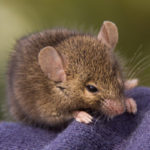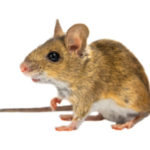House Mouse Control
The house mouse relies on humans for their quality of life. While they exist in the wild, they much prefer to live inside low-activity areas of homes, where they infect and consume food, damage structures, and chew on wires.
A house mouse can enter your home through a hole the size of a dime or cracks as wide as a pencil.
 They prefer grains and sweets but will eat other food, and bugs, if necessary.
They prefer grains and sweets but will eat other food, and bugs, if necessary.
House mice are strong swimmers and can jump up to 14 inches high. They climb walls as easily as running along a horizontal surface.
They prefer small, dark places, often nesting in wall voids, appliance voids, attics, crawl spaces and garages.
Indoors, these rodents are active and breed year-round. Females can have ten or more litters a year, averaging six new mice per litter with larger litters in the double-digits. Newborn mice reach maturity in less than a month.
Eliminating rodents quickly reduces the chance of infestation, keeps your home intact, and your family healthy.
Request a Free EstimateIdentifying an Infestation
 The house mouse is brown or gray on top with a lighter, sometimes white, underside.
The house mouse is brown or gray on top with a lighter, sometimes white, underside.
Their body is 2 to 4 inches long. They have a gray tail, mostly hairless, that is a similar length to their body. The house mouse has large, mostly hairless ears.
They are shy and usually only active during twilight or nighttime hours. Signs of a house mouse problem:
- Droppings on the floor that are long and pointed on both ends.
- A distinctive, musky odor is often a sign of heavy infestation.
- Trails from urine and pheromones along floors and walls.
- Paw prints - four toes on the front, five on the back.
- Fresh gnaw marks on wires, wood, and food packaging.
- High-pitched sounds in walls and flooring. These are usually males seeking mates.
Dangers of a House Mouse Infestation
Both short and long-term dangers accompany a house mouse population. Generally, mice are not clean creatures.
- Disease. Mice and the fleas and ticks they carry bring an increased risk of disease. The most common disease they spread is salmonella. Less often, they spread even more serious illness, like plague.
- Fire. Increased fire risk due to chewed wiring that causes electrical shorts in attics and crawl spaces.
- Insulation damage. The house mouse burrows through the insulation to make its nest and pollutes it with feces.
- Structural damage. They chew on wood to control the length of their continuously growing teeth. Over time, and with larger populations, this will harm the integrity of your home, causing safety concerns and requiring costly repair.
House Mouse Control Process
Here's how Croach® eliminates and controls your house mouse problem:
- Thorough inspection and personalized treatment plan.
- Insulation repair and replacement.
- Exclusion services to close off entry points into your home.
- Trapping in the out of the way places where mice live.
- Ongoing rodent control on the exterior to keep them outside.
- Sanitation and restoration of infested areas.
If you suspect your home or nearby neighbors' homes have a house mouse infestation, contact Croach® to schedule a free estimate consultation.
Related: Deer Mice
Request a Free Estimate

